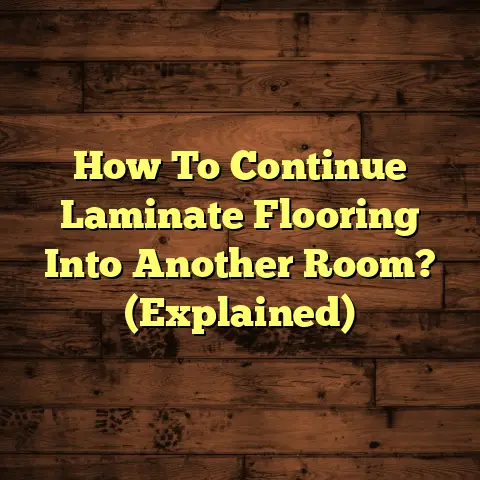Dr. Bronner’s on Floors? (3 BIG Don’ts!)
Floors? They often bear the brunt of it all – the muddy shoes, the spilled coffee, the endless parade of crumbs. And when we finally get around to cleaning, we want something effective, easy, and, ideally, eco-friendly. That’s where Dr. Bronner’s All-One Soap comes in, right?
It’s a popular choice, and I get it. But before you go sloshing that peppermint-scented goodness all over your floors, let’s talk about some crucial “don’ts.” Trust me, as a flooring contractor for over 15 years, I’ve seen it all – the good, the bad, and the downright sticky. So, let’s dive in!
The Importance of Choosing the
Right Cleaning Products
Think of your floors as a fine piece of furniture. Would you use the same cleaner on your delicate wood table as you would on your tough ceramic planter? Probably not!
Different flooring types – hardwood, tile, laminate, carpet – all have unique needs.
Dr. Bronner’s, with its organic ingredients, is definitely appealing for us eco-conscious folks. It’s become a staple in the natural cleaning community, and for good reason. It can be a great option, but only if used correctly.
The key is understanding its properties and how they interact with your specific floors.
Don’t #1 – Don’t Use Dr. Bronner’s
Undiluted on Floors
Okay, this is HUGE. I can’t stress this enough: never, ever use Dr. Bronner’s soap undiluted on your floors.
Why? Because it’s a concentrated soap.
Think of it like this: you wouldn’t drink straight orange juice concentrate, would you? You’d dilute it with water to make it palatable. The same principle applies here.
Undiluted soap leaves a thick residue. This residue doesn’t just sit there looking pretty. It attracts dirt like a magnet!
And that clean floor you were hoping for? It’ll be grimy again in no time.
Even worse, that residue can make your floors dangerously slippery. I’ve had clients call me after a slip-and-slide incident caused by too much undiluted soap. Not fun!
Here’s a real-life example: I once had a client, Sarah, who used undiluted Dr. Bronner’s on her beautiful hardwood floors. She thought she was doing them a favor with a “deep clean.”
Within weeks, her floors looked dull, felt sticky, and attracted dirt like crazy. She was mortified! It took a professional cleaning and some serious elbow grease to get them back to their former glory.
The recommended dilution is usually around 1/4 cup of soap per gallon of water, but ALWAYS check the specific instructions on your Dr. Bronner’s bottle.
Better yet, do a test spot in an inconspicuous area first to see how your floors react. Trust me, a little precaution can save you a lot of headaches (and potential falls!).
Don’t #2 – Don’t Ignore Floor Type
Compatibility
This is another biggie. Just because Dr. Bronner’s is natural doesn’t mean it’s a universal solution for all floor types.
Think of it like skincare. What works wonders for your friend’s oily skin might wreak havoc on your dry, sensitive skin. Flooring is the same.
Some floor types are simply more sensitive than others. Unsealed hardwood, for instance, is incredibly porous. It soaks up liquids like a sponge, and that includes soap.
Using Dr. Bronner’s on unsealed hardwood can lead to:
- Discoloration: The soap can stain the wood.
- Warping: Excessive moisture can cause the wood to swell and warp.
- Degradation: Over time, the soap can break down the wood’s finish.
Natural stone, like marble or limestone, is another flooring type that requires special care. These stones are alkaline and can be damaged by acidic cleaners.
While Dr. Bronner’s isn’t highly acidic, its pH level can still be problematic for some natural stone.
Always, always, always check the manufacturer’s recommendations for your specific flooring type. If you’re unsure, err on the side of caution and test in an inconspicuous area.
Here’s a table to give you a general idea:
| Floor Type | Dr. Bronner’s Suitability (Diluted) | Notes |
|---|---|---|
| Sealed Hardwood | Generally OK | Use sparingly, ensure proper dilution, and dry thoroughly. |
| Unsealed Hardwood | AVOID | Highly porous; can cause damage. |
| Tile | Generally OK | Works well on most tile types, but test on grout first. |
| Laminate | Generally OK | Avoid excessive moisture; dry thoroughly. |
| Vinyl | Generally OK | A good option for vinyl floors. |
| Natural Stone (Marble) | Use with Extreme Caution | Can etch or dull the surface. Consult a stone care professional. |
| Carpet | Spot Treatment Only | Can be used for spot cleaning, but avoid saturating the carpet. |
Important Note: This table is a general guideline. Always refer to your flooring manufacturer’s recommendations for specific cleaning instructions.
I’ve seen homeowners ruin expensive marble floors by using the wrong cleaning products. It’s a costly mistake that can easily be avoided with a little research.
Don’t #3 – Don’t Neglect Regular
Maintenance
Okay, let’s be real. Even the best cleaning products are no substitute for good old-fashioned elbow grease. Using Dr. Bronner’s (correctly!) can help keep your floors clean, but it’s not a magic bullet.
Many homeowners fall into the trap of thinking that a “good” cleaner means they can slack on regular maintenance. Not true!
Think of it like brushing your teeth. You wouldn’t skip brushing for a week just because you use a fancy toothpaste, would you?
Regular floor maintenance includes:
- Sweeping: Daily or every other day to remove loose dirt and debris.
- Vacuuming: At least once a week to remove embedded dirt and allergens.
- Mopping: As needed, using the correct cleaning solution for your floor type.
Neglecting regular maintenance can significantly shorten the lifespan of your flooring. According to the National Wood Flooring Association (NWFA), proper maintenance can extend the life of hardwood floors by 20-30 years!
That’s a huge difference!
Here’s a statistic that might surprise you: A study by the Institute of Inspection, Cleaning and Restoration Certification (IICRC) found that 80% of dirt and soil in homes is tracked in from the outside.
That means regular sweeping and vacuuming are essential for preventing dirt from grinding into your floors and causing damage.
I always tell my clients that cleaning is a process, not a one-time event. Consistent maintenance is key to keeping your floors looking their best for years to come.
Don’t rely solely on Dr. Bronner’s to do all the work. Get into a regular cleaning routine, and your floors will thank you for it.
Bringing It All Together
So, there you have it: the three big “Don’ts” when it comes to using Dr. Bronner’s on your floors.
Let’s recap:
- Don’t use it undiluted: Always dilute according to the instructions.
- Don’t ignore floor type compatibility: Make sure it’s safe for your specific flooring.
- Don’t neglect regular maintenance: Cleaning products are no substitute for routine care.
Dr. Bronner’s can be a great addition to your cleaning arsenal, but it’s crucial to use it correctly.
By being mindful of these “don’ts,” you can keep your floors clean, beautiful, and long-lasting, even amidst the hustle and bustle of modern life.
Remember, a little knowledge and a little effort can go a long way in preserving the beauty and integrity of your floors. Now go forth and conquer that dirt, responsibly! You got this!





